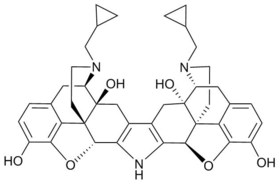Chemistry:Norbinaltorphimine
From HandWiki
Short description: Chemical compound
 | |
| Clinical data | |
|---|---|
| ATC code |
|
| Identifiers | |
| |
| CAS Number | |
| PubChem CID | |
| IUPHAR/BPS | |
| ChemSpider | |
| UNII | |
| Chemical and physical data | |
| Formula | C40H43N3O6 |
| Molar mass | 661.799 g·mol−1 |
| 3D model (JSmol) | |
| |
| |
| | |
Norbinaltorphimine (nor-BNI or nBNI) is an opioid antagonist used in scientific research. It is one of the few opioid antagonists available that is highly selective for the κ-opioid receptor, and blocks this receptor without affecting the μ- or δ-opioid receptors,[1][2] although it is less selective in vivo than in isolated tissues.[3] nor-BNI blocks the effects of κ-opioid agonists in animal models,[4][5] and produces antidepressant[6] and anxiolytic-like effects.[2]
See also
References
- ↑ "Binaltorphimine and nor-binaltorphimine, potent and selective kappa-opioid receptor antagonists". Life Sciences 40 (13): 1287–92. March 1987. doi:10.1016/0024-3205(87)90585-6. PMID 2882399.
- ↑ 2.0 2.1 "Participation of dorsal periaqueductal gray 5-HT1A receptors in the panicolytic-like effect of the κ-opioid receptor antagonist Nor-BNI". Behavioural Brain Research 327: 75–82. June 2017. doi:10.1016/j.bbr.2017.03.033. PMID 28347824.
- ↑ "Norbinaltorphimine: antagonist profile at kappa opioid receptors". European Journal of Pharmacology 144 (3): 405–8. December 1987. doi:10.1016/0014-2999(87)90397-9. PMID 2831070.
- ↑ "Nor-binaltorphimine, a highly selective kappa-opioid antagonist in analgesic and receptor binding assays". The Journal of Pharmacology and Experimental Therapeutics 246 (1): 255–8. July 1988. PMID 2839664.
- ↑ "Suppression by nor-binaltorphimine of kappa opioid-mediated diuresis in rats". The Journal of Pharmacology and Experimental Therapeutics 247 (3): 971–4. December 1988. PMID 2849679.
- ↑ "Stress increases dynorphin immunoreactivity in limbic brain regions and dynorphin antagonism produces antidepressant-like effects". Journal of Neurochemistry 90 (5): 1258–68. September 2004. doi:10.1111/j.1471-4159.2004.02589.x. PMID 15312181.
 |

